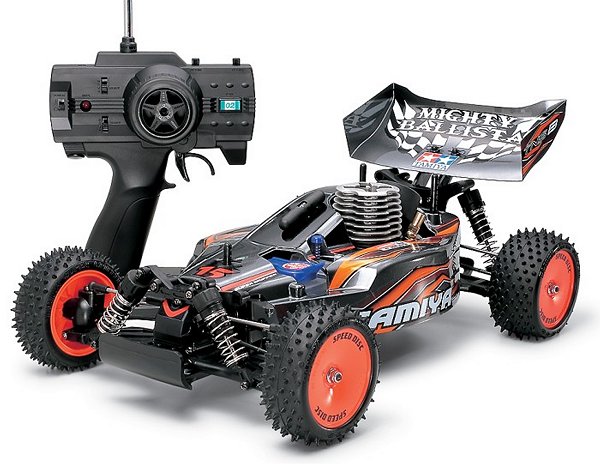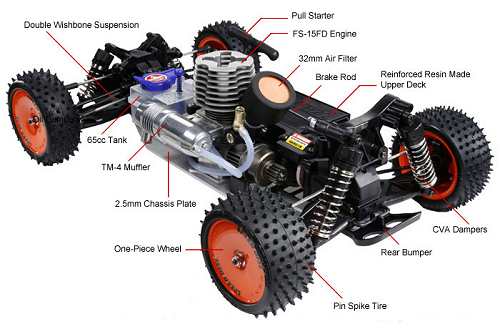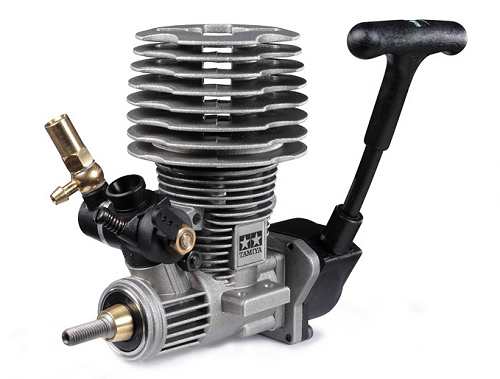

|


|
Tamiya XBG Mighty Ballista - 43535
|
Released by Tamiya on April 26, 2008, the 4WD XBG Mighty Ballista Buggy - # 43535 - is No.35 in the Expert Build Factory Assembled Glow-Engine RC Car Series and is based on the TNS-B15 chassis, with an FS-15FD engine.

The model is shaft driven, on an alloy plate chassis, with gear type differentials, coil spring over oil filled dampers, dogbone drive-shafts, bushings and some ball bearings.
Like the majority of Tamiya RC models, this model comes with plastic and sintered brass bush type bearings, that after a short while, when dust and grit get into them, actually abrade the metal shafts that spin in them - our recommendation is that these should be replaced by steel shielded ball bearings ASAP.
To race the Tamiya Mighty Ballista, it needs to be tuned to perfection for better stability, precise steering and provide enough grip to keep you on the track when going around tight bends at high speed. Even the smallest adjustment can change the feel of a car and our simple to follow instructions will guide you to the best Set-up to get you to the front and keep you there.








|
|
|

|


Buying a Used Tamiya Mighty Ballista Buggy (and What to look for)
Make a General Visual Inspection
Check the Body-Shell
If the body shell of your Tamiya Mighty Ballista is broken, ripped or damaged in any way, this can be easily repaired with rubber solution glue. Also, for added protection and if available for your Mighty Ballista model, fit an under guard to stop dirt and gravel entering the chassis. Drive Shafts and Turnbuckles
Examine the Drive System
The gearbox of your used Buggy should be opened up to check for gear wear and lubrication. A thin coat of grease is often used on internal gears and although this is fine for basic running around on the back yard, if you intend to race your Buggy at a higher level, this should be removed and replaced with racing oil (ZX1 or Teflon Oil). Of course, this should be reapplied after each race meeting. Pinions and Spur Gears
Don't Neglect the Ball-Joints
Ball joints always cause problems. For top level Nitro Buggy racing, the plastic ball connectors should be checked and if deemed necessary changed after every meeting. A simple thing like a loose fitting connector popping off could easily end your race, so better safe than sorry. Steering Servo and Servo-Saver
Stabilizers
If body roll on your Tamiya Mighty Ballista is a problem, handling can be improved with the use of stabilizers, anti roll or sway bars, stiffer tuning springs and, or, thicker silicone oil in the dampers. Don't Forget those Bearings
▼ Scroll Down for More Articles and Advice ▼
Or, check out our RC Model Car Setup Guide
|









|






|
|
|
|
Hints, Tips and Information
The Importance of Suspension Droop
When you pick up your RC model car, the suspension arms naturally drop, this is termed as Droop and should be equal from side to side, but can vary from front to rear. |
|
Hints, Tips and Information Make your RC Model Ball Bearings Work for You
If you are serious about your racing, looking after your bearings is essential if you are to remain competitive. |
|
RC Models:
|
Radio & Motors: |
Other
Accessories: |